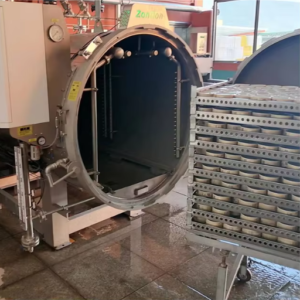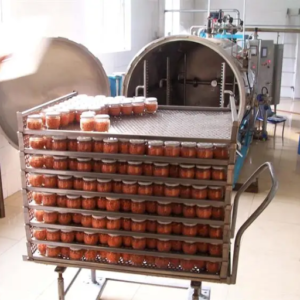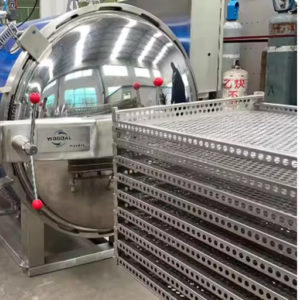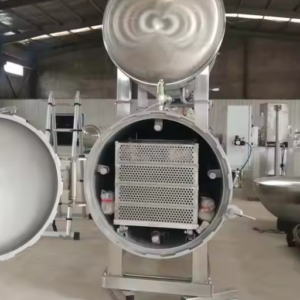In food preservation, autoclaves are essential to ensure that canned food products are safe and have long shelf life. This guide is intended to help readers understand the various aspects of selecting their ideal food sterilization machine. We will offer our expert insights and some practical tips on making an informed decision regarding understanding the science behind sterilization and exploring different types of autoclaves on the market. It does not matter if you are a home canning enthusiast or work in a commercial food processing plant; this article equips you with basic knowledge to choose an autoclave that suits your needs and enhances your efforts towards preserving food.
What is a Canned Food Sterilization Machine, and How Does it Work?

Image source: https://www.alibaba.com/
An autoclave, also known as a canned food sterilization machine, is used for canned foods where it uses high-pressure steam to remove any dangerous microorganisms & bacteria. The process involves placing food in sealed cans before putting them inside autoclave chambers. As the machine gets heated up, steam comes out, increasing internal pressure & temperature. This effectively kills harmful agents, thus making it fit for human consumption while prolonging its life span. To achieve necessary temperatures around 240°F (this apparatus ensures 116°C) or higher, thorough sterilization is also an indispensable tool in home canning and commercial food processing.
Understanding the Basics of Food Sterilization
Food sterilization is a necessary process that removes all forms of life on food products, such as bacteria, viruses and spores, to make them safe. This can be done using several methods, but heating is the most common. Usually, sterilization involves exposing foods to high temperatures for some time to kill pathogens and spoilage organisms, among others. Other methods include chemicals used in sterilizing food, such as hydrogen peroxide or ozone, and irradiation, whereby food is exposed to ionizing radiation. The choice of method often depends on the type of food involved, expected shelf life, and specific micro-organisms being targeted. Such knowledge equips consumers and producers with the information necessary for making food preservation and safety decisions.
The Role of an Autoclave in Canned Food Sterilization
Canning is done mainly through an autoclave, which creates a high temperature-high-pressure environment capable of eliminating harmful microbes in canned foods. In the autoclave, filled cans are put first before steam is introduced, raising internal temperatures above 250°F (121°C). By ensuring the heat reaches lethal levels even for resistant spores, which could lead to spoilage or diseases from consuming contaminated packaged items, this extreme hotness lasts for a recommended period during which it kills any heat-resistant spore, thus preventing spoilage and ill-health caused by eating tainted canned products. Moreover, the consistency in pressure applied throughout heating-cooling cycles by an autoclave reduces the chances of damage to the can, thereby ensuring that the contents remain unaltered. When it comes to meeting food safety standards imposed on domestic canning as well as large-scale commercial production, achieving uniformity in heat penetration remains obligatory; hence, the usage of pressure cookers, otherwise known as autoclaves, cannot be underestimated by manufacturers alike.
Key Differences Between Sterilization Methods
Sterilization methods differ in many areas, notably in effectiveness, application, and limitations.
- Heat Sterilization: This method, which includes autoclaving, employs high temperatures to eliminate microorganisms. It is very effective for liquids and solids but may harm heat-sensitive items. Applying the proper temperature and time renders this procedure fast and dependable.
- Chemical Sterilization: Ethylene oxide or hydrogen peroxide gas techniques sterilize heat-sensitive medical devices well. However, these gases are toxic to various living forms, so longer exposure durations and caution when handling them are needed.
- Radiation Sterilization: Ionizing radiation can kill bacteria and other germs; it is suitable for products that cannot bear high temperatures or chemicals, like pharmaceuticals and plastic drugs. However, product integrity concerns and the necessity for specialized equipment might limit its use.
It is essential to select an appropriate sterilization process depending on whether it’s a specific product type, the level of sterility assurance anticipated, and safety requirements because each has advantages and disadvantages.
How to Choose the Right Sterilization Machine for Your Needs?

Several key factors must be considered when choosing a suitable sterilization machine. The first is the type of substance that must be sterilized. Also, determine if heat or chemicals are sensitive to them; this will help determine whether heat chemical or radiation sterilization is appropriate. Additionally, consider the volumes of processing you require: more extensive facilities might prefer industrial sterilizers and high-capacity autoclaves, while compact units could serve smaller ones. Furthermore, examine the recommended sterility assurance level (SAL) for your goods because it will help you select a machine that ensures efficient sterilization. Finally, consider budget limitations and maintenance costs since good machines may have higher initial costs but will bring reliability and durability in the long run. Based on these considerations, you can pick a sterilization machine that optimally suits your operational needs and safety standards.
Types of Sterilizing Machines: Autoclave vs. Retort
When comparing retorts with autoclaves, we should first understand what each does in terms of its specific function within any sterilization process done in them. This is in contrast to other methods used in healthcare settings, like gravity displacement, which is widely used in healthcare settings.
On the contrary, retorts rely on different techniques, primarily steam or boiling water, to eliminate microorganisms from packaged foods. This method is essential to ensure food safety and extend shelf life, especially within the canning industry. Autoclaves frequently use temperatures lower than those applied by retorts but last longer so that thermal penetration occurs inside products.
Whether one opts for an autoclave or retort depends on the intended application area. Autoclaves play a significant role in medical environments and laboratories, while retorts are indispensable in the food processing and preservation industries.
Critical Factors to Consider When Buying a Sterilizer Machine
When purchasing a sterilizer machine, some crucial factors should be considered to ascertain that it meets all the requirements. To start with, check its capacity and size because you need a machine that can handle your work without taking up too much space. In addition, depending on the types of materials to be sterilized, which sterilization method do we choose—autoclave or retort?
Another important factor is ease of use and maintenance; machines that need less attention are time-saving and cost-effective in terms of resources used, while an easy-to-use interface can make the process more efficient. The energy consumption of the machine must also be probed since more effective models can result in considerable savings in the future. Finally, ensure compliance with regulations and any necessary certifications because safety standards are essential for medical and food processing purposes. These considerations will help you choose a suitable sterilization machine for your operation needs.
Top Features to Look for in a High-Pressure Autoclave
Several key factors must be considered when choosing a high-pressure autoclave to ensure optimal performance and reliability.
- Temperature and Pressure Control: Look for precise temperature and pressure settings that can be easily monitored and adjusted. This ensures a consistent sterilization process, which is vital for different materials.
- Built-in Safety Mechanisms: Advanced autoclaves have features like pressure release valves and over-temperature protection, among others. User safety during operation cannot be overemphasized, hence preventing avoidable accidents.
- User-Friendly Interface: A clear display and intuitive controls can significantly improve ease of use. Some models have digital interfaces with programmable options, which makes them easy to operate or monitor.
- Cycle Efficiency: Check out models with shorter cycle times that can still provide effective sterilization. This improves productivity, especially in high-demand scenarios.
- Durability and Build Quality: Quality construction materials extend the life of the autoclave and improve its performance. Resistance to rusting and wear makes stainless steel components preferable in many cases.
- Validation and Data Logging Capabilities: To comply with regulatory standards, select an autoclave with validation options and data logging capabilities. This guarantees proper record-keeping on all sterilization cycles, which ensures quality assurance.
Considering these features, one can pick out a high-pressure autoclave that meets their operational requirements while ensuring conformity with safety regulations.
What Are the Benefits of Using an Autoclave Sterilizer for Canning?

Several key advantages to using an autoclave sterilizer for canning boost food safety and preservation. First, high temperatures produced by autoclaves effectively eliminate bacteria, molds, and spores so that canned goods become safe to eat. Furthermore, they ensure uniform sterilization across all jars, minimizing spoilage risks and extending the shelf life. This also improves the process’s dependability as control and monitoring of sterilization cycles cater to different types of food and their densities. Lastly, autoclaving is an ideal method for preserving food’s nutritional value and flavor, making it a suitable option for household canners or even commercial processors.
Ensuring Food Safety with High-Pressure Sterilization
Using autoclaves in high pressure sterilization is essential for ensuring food safety. In these instances, autoclaves create conditions capable of effectively killing harmful microorganisms, including spores, thus causing contamination, among other related diseases, through applying heat in addition to pressure. Leading websites have found steam combined with pressure on food safety to speed up the process and permeate food substances more thoroughly than conventional methods. It is worth noting that such measures prevent spoilage while conserving nutrients, ensuring that canned products last longer and remain nutritious until consumption time. Therefore, high-pressure sterilization procedures are necessary to make safe preserved foods for cannery activities that yield good quality ones, too.
Improving Shelf-Life of Canned Food Using Sterilization Equipment
Sterilization equipment such as autoclaves is necessary for canned food to stay on the shelf longer. It has been established from reliable sources that high-temperature sterilization kills bacteria and spores and significantly decreases the chance of spoilage. Websites addressing the preservation of foods indicate that proper pressure and temperature must be maintained in the sterilization cycle to achieve optimum efficiency. Furthermore, sealing jars after sterilization ensures no decontamination, thus enhancing stability. To ensure durability and safety for preserved food items, monitoring and calibrating sterilizing equipment at all times is essential.
Cost-Effectiveness and Efficiency in Food Processing
Investment in new-age sterilization technologies like high-pressure sterilization provides significant cost-effectiveness and efficiency in food processing. These methods significantly reduce energy consumption, often associated with traditional techniques used for sterilizing. In addition, superior contamination elimination leads to less waste product due to spoiling. Food processors can lower production costs by streamlining operations while increasing output and maximizing profit margins. Also, the long shelf lives of canned products achieved through these efficient sterilization practices are consistent with consumer demands for quality and safety, meaning that current methods of modern sterilization are indeed an asset in today’s competitive food processing industry.
How to Maintain and Operate Your Canned Food Sterilization Machine?

To achieve efficiency in your canned food sterilization machine, there is a need for regular maintenance and proper operation. This starts with regularly checking and cleaning the machine’s components, including valves, seals, and filters, to avoid contamination and ensure it remains efficient. It’s essential to conduct thorough inspections after each use, looking for any signs of wear or damage that could affect functionality. Follow the manufacturer’s guidelines for calibrating temperature and pressure settings, which are crucial to effective sterilization. Moreover, keep a log of all maintenance performed on the machine and any irregularities noticed during its performance. Observing such will extend the machine’s lifespan while ensuring that canned products are safe and high-quality.
Best Practices for Operating an Autoclave Sterilization Machine
Some best practices must be followed to operate an autoclave sterilization machine efficiently.
- Pre-Cycle Preparation: Before starting the sterilization cycle, ensure all instruments have been appropriately cleaned and dried. Packaging materials designed for autoclaves should be used to maintain sterility post-cycle.
- Loading the Autoclave: Load the autoclave cautiously, allowing space between items for steam circulation so overcrowding does not happen, which may hinder proper sterilization. To maintain balance, heavier items should be placed on bottom shelves and lighter ones on top.
- Monitoring Sterilization Parameters: Always check temperature and pressure settings to ensure they comply with manufacturer recommendations. Use available indicators, such as autoclave tape or biological indicators, to verify the successful sterilization process.
- Routine Maintenance: Clean filters and check seals on a regular basis for your autoclave. Professional servicing should be carried out according to the manufacturer’s schedule to keep it functional.
- Documenting and Reviewing Cycles: Each sterilization cycle must be reported, with deviations from standard operating procedures noted and results obtained from them. Consequently, data can be reviewed periodically for recurrent alarms to further investigate or troubleshoot.
By following these best practices, operators will improve the reliability and efficiency of their autoclave sterilization processes, ensuring that all sterilized products are safe and of good quality.
Routine Maintenance Tips for Long-lasting Performance
- Regular Cleaning: Clean the autoclave chamber, door, and seals regularly to avoid debris and contaminants building up that may reduce their performance. When cleaning these items, use non-reactive detergents that are compatible with sterilizing equipment.
- Inspect Seals and Gaskets: Regularly check the door seals and gaskets for damage. Replacing them is a must to keep the integrity of the sterilization cycle intact and prevent steam leaks.
- Water Quality Management: Use distilled or demineralized water in an autoclave. Check water quality often to prevent mineral build-ups, which can negatively impact sterilization and machine lifecycle.
- Calibration Checks: Periodically test the temperature and pressure sensors used by an autoclave. Ensuring accurate calibration of such features helps maintain effective sterility and reliability throughout cycles.
- Follow Manufacturer Guidelines: Adhere to the manufacturer’s maintenance schedule and recommendations. This will involve service intervals for professional maintenance, among other specific products or parts that might require attention over time.
By following these tips, you will give your autoclave a longer lifespan while improving its efficiency, thus enabling it to meet the high standard requirement for effective sterilization consistently.
Standard Troubleshooting Issues and How to Solve Them
- Steam Leaks: One of the most common problems with autoclaves is steam coming out the door. If you find steam being lost from your autoclave while it is running, you should check whether the door seals and gaskets have been damaged or worn due to misuse. Replace them if they are broken, however, to maintain the proper sealing.
- Insufficient Sterilization: If loads do not come out sterilized, one has to look for proper loading techniques where there is no overcrowding and steam can circulate freely. Also, verify that temperature and pressure settings are properly calibrated. On a regular basis, carry out maintenance on the autoclave to prevent temperature variations that may affect sterilization.
- Error Messages: Autoclaves may display error codes indicating malfunctions or operational failures. For specific error codes and their meanings, consult the manufacturer’s manual. Sometimes, resetting the machine can solve small issues, but constant errors indicate a need for professional servicing to avoid similar occurrences in the future.
Users who address these issues promptly and follow routine maintenance procedures will be able to make sure their autoclave runs smoothly while ensuring its longevity.
What Are the Latest Advancements in Sterilization Technology?

In recent years, significant advances in sterilization technology have aimed to improve efficiency, efficacy, and safety. An exciting development has been the incorporation of nanotechnology into sterilization processes, which boosts microbial destruction to the molecular level. Furthermore, new steam sterilization methods now employ advanced monitoring systems that provide real-time data on cycle parameters for optimum performance and safety guarantees. Additionally, sterile processing departments are increasingly adopting automated and robotic systems to streamline workflow by reducing human errors and saving time. These improvements make sterilization more reliable while helping reduce environmental impact through eco-friendly materials and practices in this field.
Introducing Terra Food-Tech® and Other Innovations
Terra Food-Tech® is an original food processing and sterilization model that merges up-to-date technology with sustainable practices. It uses new steam sterilization techniques that guarantee food safety and preserve nutrients. The Terra Food-Tech® comes with intelligent sensors and IoT connectivity that allow it to monitor real-time data while optimizing performance to minimize wastage. Other innovations in this area include converting food waste into bioplastics that reduce pollution and provide a valuable solution for sustainable packaging alternatives. Such improvements demonstrate a broader commitment to bettering nutritional standards while meeting the rising demand for eco-friendly operations in the food industry.
The Future of Food Sterilization Machines
Advances such as automation, artificial intelligence, and sustainability will shape the future of food sterilization machines. Leading firms are producing devices that go beyond sterilization by integrating intelligent technologies that improve efficiency and enable monitoring. An example is AI algorithms, which are expected to change load management and cycle optimization, leading to machines being able to adapt in real time depending on specific types of processed foods (Hank et al., 2016). Furthermore, more emphasis is put on renewable energy sources and materials when designing systems for sterilizing, following increased attention to sustainability. On the other hand, there is growing use of environmentally friendly techniques such as waterless methods of steam plus the inclusion of biodegradable materials, resulting in safer alternatives within strict safety boundaries (Hank et al., 2016). Finally, blockchain technology should assist manufacturers in operating with transparency within their processes, especially regarding quality assurance, through the ability to prove the effectiveness of their sterilizations, thus revealing this process’s efficacy to buyers.
Frequently Asked Questions (FAQs)
Q: What is an autoclave for canning?
A: An autoclave for canning is a food sterilization machine designed to preserve and sterilize food by exposing it to high temperature and pressure. This ensures the safety and longevity of canned food products by eliminating viable microorganisms in food.
Q: How does a canned food sterilization machine work?
A: A canned food sterilization machine uses steam to heat the food inside the containers to a high temperature. This process is known as autoclave sterilization, and it effectively destroys harmful bacteria and microorganisms, making the canned food safe and extending its shelf life.
Q: What are the benefits of using a high pressure autoclave for food processing?
A: Using a high-pressure autoclave for food processing offers several benefits, including enhanced food safety, extended shelf life for food products, and the ability to preserve the nutritional value and flavor of the food. It also ensures the sterilization of canned foods without chemical preservatives.
Q: What types of food can be sterilized using a food sterilization machine?
A: A food sterilization machine can sterilize a variety of food products, including fruits, vegetables, meats, dairy products, and even pet food. This machine is versatile and suitable for preserves and ready meals, ensuring comprehensive food safety across different types of food containers.
Q: Why is water used in the sterilization process of canned foods?
A: Water is used in the sterilization process of canned foods to generate steam, which helps elevate the temperature inside the sterilizer machine. This high-temperature steam effectively kills bacteria and microorganisms, ensuring the canned food is safe for consumption and has an extended shelf life.
Q: What are the key features to look for in a food sterilization pot?
A: When choosing a food sterilization pot, look for features such as temperature and pressure control, durability, capacity, and ease of use. It’s also essential to ensure that the sterilization pot complies with food industry standards for safety and efficiency in sterilizing food products.
Q: Can you explain the difference between autoclave sterilization and pasteurization for food?
A: Autoclave sterilization and pasteurization are both methods to ensure food safety. Autoclave sterilization uses high temperatures and pressure to eliminate viable microorganisms in food, making it highly effective for canned foods. Pasteurization, on the other hand, uses lower temperatures to kill most but not all bacteria, extending shelf life while maintaining food quality. Pasteurization is commonly used for dairy products and juices.
Q: How do industrial autoclaves support food safety in large-scale food processing?
A: Industrial autoclaves support food safety in large-scale food processing by providing a reliable means to sterilize large batches of food products efficiently. These machines ensure consistent high temperature and pressure, which are crucial for destroying harmful microorganisms across all containers, thereby maintaining high food safety and quality standards.
Q: What is a microwave sterilization machine, and how does it differ from a steam sterilizer?
A: A microwave sterilization machine uses microwave energy to heat and sterilize food, whereas a steam sterilizer relies on high-temperature steam to achieve sterilization. Microwave sterilization tends to be faster and may have different effects on the texture and taste of food compared to traditional steam sterilization methods.
Q: Where can I get wholesale options for a food retort system?
A: Wholesale options for a food retort system are available from various manufacturers and suppliers specializing in food processing equipment. It’s advisable to research and contact companies offering a wide range of food sterilization equipment to ensure you find a system that meets your needs and budget.












